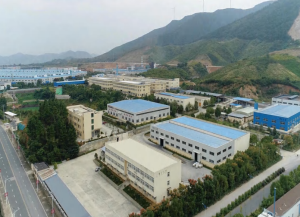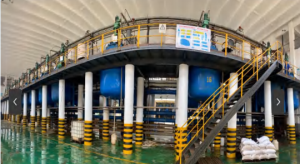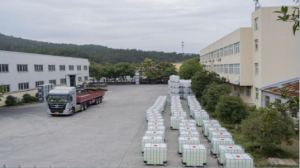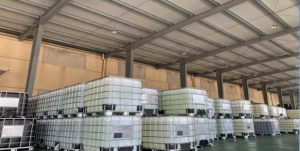
Two products are recommended for water treatment: STPP and dimethyldiallyl ammonium chloride.


一.product name: Sodium tripolyphosphate (STPP)
Product features:
Sodium tripolyphosphate (STPP) is a white powder with the formula Na5P3O10. It has good water solubility and can be quickly dissolved in water. Due to its strong acidity, sodium tripolyphosphate is widely used in water treatment.
Application field :
- Remove impurities from water: sodium tripolyphosphate has good complexation ability, and can complex impurity ions such as iron, copper and manganese in water to form a stable complex, so that impurity ions are fixed in it, so as to facilitate subsequent precipitation treatment or filtration treatment.
- Prevent scale formation: Sodium tripolyphosphate can be complexed with calcium and magnesium plasma to form insoluble sediments, thereby reducing the content of calcium and magnesium ions in water and preventing the formation of scale.
- Corrosion inhibition: After the decomposition of sodium tripolyphosphate, phosphate can be formed to prevent metal corrosion, and metal pipes and equipment of the facility can be protected in water treatment.
- Deodorization: Sodium tripolyphosphate also has the effect of removing odor from the water, so that the odor substances in the water are gathered together, which is convenient for subsequent treatment.
- Catalytic coagulant: sodium tripolyphosphate can also catalyze the precipitation of silicate and aluminum salt and other water purification agents, thereby promoting the mud precipitation rate and improving the efficiency of water purification.


二.product name: dimethyl diallyl ammonium chloride DADMAC
Product features :
This product is an aqueous solution of dimethyl diallyl ammonium chloride, which can be miscible with water in any ratio, and the product has no pungent odor and slight consistency. This product is a polymeric grade, high charge density cationic monomer, the molecular structure contains alkenyl double bonds, can form a linear homopolymer and various copolymers through various polymerization reactions. This product is very stable at room temperature, non-hydrolyzing, non-flammable, little irritation to the skin, low toxicity.
Application field :
DADMAC is formed as a cationic monomer by homopolymerization or copolymerization. The polymer can be used as a superior aldehyde-free color fixing agent in textile dyeing and finishing additives to form film on fabrics and improve dyeing fastness. In the paper auxiliaries can be used as retention aid filter aid, paper coating antistatic; In the water treatment process can be used for decolorization, flocculation and purification, efficient and non-toxic; In daily chemicals, it can be used as grooming agent, wetting agent and antistatic agent for shampoo; In oilfield chemicals, it can be used as flocculant, water blocking agent, etc. Its main function is electric neutralization, adsorption, flocculation, purification, decolorization, especially as a modifier of synthetic resin, giving electrical conductivity, antistatic property.
Use:
DMDAAC is used as a cationic monomer to form polymers through homopolymerization or copolymerization. Its homopolymer and polymer with other monomers (diallyl amine) can be used as superior aldehyde-free color fixing agent in textile dyeing and finishing additives to form film on fabrics and improve dyeing fastness. In paper auxiliaries can be used as retention filter, paper coating antistatic; In the water treatment process can be used for decolorization, flocculation and purification, efficient and non-toxic; In daily chemicals, it can be used as grooming agent, wetting agent and antistatic agent for shampoo; In oilfield chemicals, it can be used as flocculant, water blocking agent, etc. In the paper industry and other monomers can be used as dry and wet strength agent, retention and filter aid. Its main function is electric neutralization, adsorption, flocculation, purification, decolorization, especially as a modifier of synthetic resin, giving electrical conductivity, antistatic.
Structure and property :
In general, coassemblies of 1, 6-diolefins produce five – or six-membered rings on the main chain. DMDAAC reacts as a monomer to form only a five-membered ring. Only four-membered isomers of pyrrolidine were detected by 13C-NMR spectroscopy. By changing the conditions of synthesis, such as changing the solvent, anion or radiation initiation, or replacing the N atom in the structure with other atoms, no change was found in the size of the ring, the cis-trans structure ratio of 6:1. In the case of 1, 6-diolefin symmetry, the degree of cyclization is generally higher. The same general rule applies to DMDAAC. PDMDAAC obtained by polymerization of 203 Hg-acetate solution contained only 0.1-3% double bonds. The cyclization growth rate constant is two orders of magnitude larger than the linear growth rate constant for forming overhanging double bonds. Therefore,PDMDAAC mainly contains a ring structure formed by connecting -CH2-CH2 – at the 3 and 4 positions of the monomer, and a small amount of structures with overhanging double bonds formed by linear polymerization of the monomer. PDMDAAC and P(DMDAAC/AM) are white and easily absorbable powders or particles, depending on the polymerization method. Its shape is also different. Soluble in water, methanol and glacial acetic acid, insoluble in other solvents; The commodity is generally aqueous solution. It is neutral and slightly yellow when dried. At room temperature, PDMDAAC aqueous solution is stable in the pH range of 0.5 ~ 14, and P(DMDAAC/AM) aqueous solution is partially hydrolyzed in alkaline medium. Both homopolymer and copolymer molecules are positively charged, aqueous solution and hygroscopic solid powder are conductive, and the conduction mechanism is ion migration conduction.
